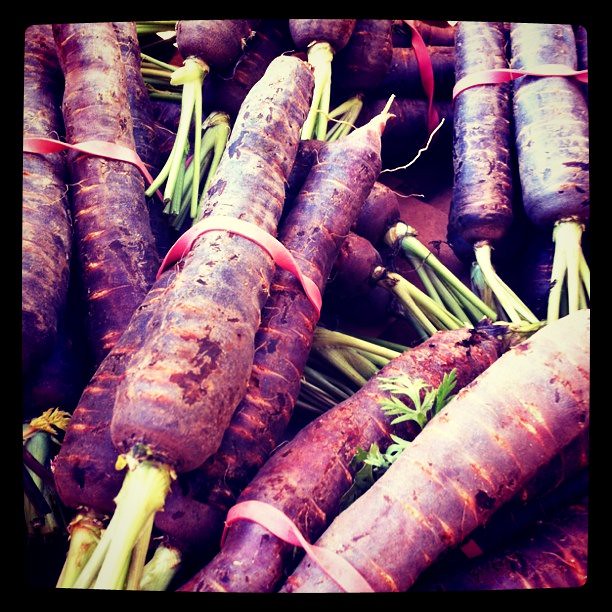You might have heard of genetically modified organisms
(GMOs), foodstuffs with their genetic material altered to make them easier to
cultivate, or more nutritious. You might have heard that meat is being grown inlabs, set to become a more efficient alternative to the stuff that has to
bother with being an animal before it’s a food. You may have heard the word ‘Frankenfoods’
which, to be perfectly honest, is just fear-mongering. What you probably
haven’t heard is that carrots, when we originally started cultivating them,
were a rather exciting shade of purple, but that some savvy European farmers
bred the orange hue we know and love into them along the route to making them
more nutritious. You almost certainly haven’t heard that wheat, as we know it
today, is the result of centuries of cross-breeding of different grass species. And I’m sure you never heard cabbage,
broccoli, brussels sprouts, and kale were all once the same foul-tasting yetedible plant – which ancient humans bred into several different edible yet
foul-tasting plants, for some reason.
Carrots as they once were
Source: flickr user Carl Black, Cosmic Purple Carrots, 2011.
Yes, dear readers,
genetic modification of that which we put into our bodies is so prevalent that
almost everything you eat has, in one way or another, been subject to it.
Nothing that we farm is the same as the ancestor species we found in the wild,
and adapted to our needs. Be it for taste, ease of harvest, or just to see what
would happen, humans have been altering our food for thousands of years
(Barrows et al, 2014). But it’s only recently that we started doing it in
laboratories, and that’s when people started getting angry.
Genetically modified
organisms (GMOs) have been a point of much contention since they were first
developed; the thought of mixing up genetic material can seem a bit
frightening, verging on the mad-scientist trope we all know and love. But they’re
out there already, growing in fields and sitting around in our food. Or our
food’s food; soybeans are one of the most common GMOs, and one of their main
uses is to feed livestock (Jacobsen et al, 2013). I, personally, have nothing
against GMOs, although I won’t deny that they come with their own unique set of
issues and controversies. But first, let’s talk about the positives.
Hunger is a big issue
on this planet. I’ve mentioned this before; it’s kind of hard to avoid on an
agriculture blog. Around 1 billion people live without enough food (Jacobsen et
al, 2013), and even more live off diets that are lacking in some important
nutrient like iron or vitamin a. The fact of the matter is, with a growing
population, we need to find new ways to feed everyone. And this week I’m
focussing on the potential from GMOs. High-yield varieties; there’s something
good. More food, less land. Intensive, yes, but less land being used means less
biodiversity lost, although it does also put more stress on the land in
question. And let’s not forget that, with the impacts of climate change, it is
going to be harder and harder to cultivate crops; growing seasons will change,
and plants may no longer be suited to the environment around them, not to
mention the migration of new pests into their areas. While genetic modification
does take time, what with development and field tests, it’s still faster than
selective breeding in creating pest-resistant or hardier strains (Qaim and Zilberman, 2003). Not to mention nutritional improvements; genetic modification
to change the nutritional contents of a crop. Some (Borlaug, 2000) are hopeful
about this kind of alteration, although there seem to be few real examples out
there. Golden Rice springs to mind, engineered for vitamin a, which is hardly a
bad idea.
However, GMOs have
their downsides as well. Patenting of genetic material means that these strains
can only be bought from their parent companies, and farmers may not be allowed
to keep seeds from their yield to plant a new crop (Jacobsen et al, 2013). It
leads to a monopoly, with companies like Monsanto controlling the majority of
the cotton market with specialised breeds such as Bt cotton, popular in India
(Qaim and Zilberman, 2003).
But one of the
biggest concerns associated with GMOs is the transfer of these modified
genetics to the species’ wild counterparts. It’s all fun and games until the
weeds become weed-killer resistant. The process isn’t just as simple as one
bout of pollen transfer, as figure 1 shows, but nonetheless the possibility of
genetic transfer is real (Stewart et al, 2003), and the notion of some of these
traits getting out of hand and into the wild is somewhat concerning. One of the
biggest issues with agriculture is that is changes ecosystems, having negative
ecological consequences; adding rogue ‘transgenetic’ material into the mix doesn’t
seem like the best of ideas, somehow.
Figure 1: Gene-flow pathways between GMOs and their wild counterparts, in the event of interbreeding leading to slow hybridisation.
Source: Stewart et al 2003.
Source: Stewart et al 2003.
I’m still not opposed
to GMOs, but I will admit that even my opinion of them has changed a little
during my research into them. They’re a good idea; they’re already out there,
feeding more people than their un-modified counterparts could, and that’s
nothing to sniff at. But they’re not a perfect solution to the hunger and
ecological problems facing the world, and while we should always bear them in
mind as an answer to the issues of the potential agracpocalyse, we also need to
remember that they come with a risk or two.


No comments:
Post a Comment